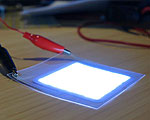3D-Printed Lightpaper Adds Light Anywhere
 Nov-30-14
The ultra-thin, 3D-printed Lightpaper could have a wide range of applications—if we could just figure out what they are.
Nov-30-14
The ultra-thin, 3D-printed Lightpaper could have a wide range of applications—if we could just figure out what they are.The paper-thin Lightpaper, which can be applied on almost any surface, is made by combining ink and tiny LEDs and then printing the mixture on a conductive layer. When a current runs through the paper, the tiny, randomly-placed diodes will illuminate.
One problem with the material, however, is the random dispersions of the diodes, which causes the light to have a sort of shimmery effect. While Rohinni CMO Nick Smoot believes the shimmering will not be a problem for many applications, the team is working on a way to place the diodes more precisely to create a steady light.
More Info about this Invention:
[FASTCOLABS.COM][ROHINNI.COM]
Add Comment
safety clothing would benefit from this technology. too many road construction workers get killed each year.
Posted by Chris Gallagher on December 1, 2014
Hmmm. I wonder if this is a cost or performance improvement over electroluminescent panels.
Posted by CJ Skinner on December 3, 2014
I wonder if the use of 4D printing technology would be able to solve the issues of the randomly placed diodes; automatically realigning themselves over time.
Posted by Calexis Mabalot on December 5, 2014
I would like to see the result of layers of these paper light-panels set up in the same way as capacitors to see if the light could be stabilised and multiplied like electrical current is stored in a capacitor. Theoretically, it might seem a waste of time, but sometimes something we don't know about is discovered by defying conventional thinking, and the only way to prove or disprove this being possible is by trying it.
Posted by Kevin Oxley on December 5, 2014
Perhaps a magnetic field could be used to automatically align the LED's in north/south polarity simply by either attaching a ferrous metal to the led's or a static charge applied to the surface. This could would align the leds also, but either method could be developed into a solution to the problem. Another possibility might be to use high levels of vibration which causes alignment of larger particles into parallel arrays, like the analogy of logs flowing in a river, or matches in a box aligning in parallel when shaken.
Posted by Kevin Oxley on December 9, 2014
Optical fibre would be the ideal connective material lighting the capacitor stack. Wire is used for connecting the current to illuminate the led's.
Also, Primary and secondary windings of optical fibre around a glass rod might provide some interesting results as a form of induction of light instead of electricity, constructed similar to a transformer.
Of course, the aforementioned concept for capacitors could also be applied in a conventional rolled, ribbon form.
Experiments on random questions can provide useful insights for other ideas.
Posted by Kevin Oxley on December 9, 2014
fields are required.
Comments
safety clothing would benefit from this technology. too many road construction workers get killed each year.
Posted by Chris Gallagher on December 1, 2014
Hmmm. I wonder if this is a cost or performance improvement over electroluminescent panels.
Posted by CJ Skinner on December 3, 2014
I wonder if the use of 4D printing technology would be able to solve the issues of the randomly placed diodes; automatically realigning themselves over time.
Posted by Calexis Mabalot on December 5, 2014
I would like to see the result of layers of these paper light-panels set up in the same way as capacitors to see if the light could be stabilised and multiplied like electrical current is stored in a capacitor. Theoretically, it might seem a waste of time, but sometimes something we don't know about is discovered by defying conventional thinking, and the only way to prove or disprove this being possible is by trying it.
Posted by Kevin Oxley on December 5, 2014
Perhaps a magnetic field could be used to automatically align the LED's in north/south polarity simply by either attaching a ferrous metal to the led's or a static charge applied to the surface. This could would align the leds also, but either method could be developed into a solution to the problem. Another possibility might be to use high levels of vibration which causes alignment of larger particles into parallel arrays, like the analogy of logs flowing in a river, or matches in a box aligning in parallel when shaken.
Posted by Kevin Oxley on December 9, 2014
Optical fibre would be the ideal connective material lighting the capacitor stack. Wire is used for connecting the current to illuminate the led's.
Also, Primary and secondary windings of optical fibre around a glass rod might provide some interesting results as a form of induction of light instead of electricity, constructed similar to a transformer.
Of course, the aforementioned concept for capacitors could also be applied in a conventional rolled, ribbon form.
Experiments on random questions can provide useful insights for other ideas.
Posted by Kevin Oxley on December 9, 2014
Add your Comment:
[LOGIN FIRST] if you're already a member.fields are required.

Show 6 Comments